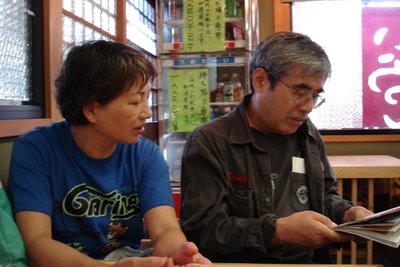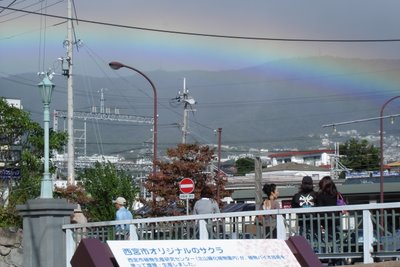Nara Prologue: Golden Light

On the first weekend of October Pat's homestay parents (pictured, they're wonderful, I can't for the life of me remember their names) took me, Pat and our friend Crystal to Nara for a romp around the temples there. There are a lot of them, and I mean a lot.
Nara was the capital of the Japanese state during the years 710 to 794, at that time it was called Heijo. This was a time of rapid expansion and growth for Buddhism, which had been imported from China by way of Korea beginning in the middle of the sixth century.
The speed with which Buddhism, a foreign religion, managed to infiltrate and to some extent dominate native Shinto in the years before the move to Heijo is surprising. Though several families at court had vested interests in promoting Shinto, the Soga clan, an immigrant clan that had taken responsibility for Buddhism, managed to emerge victorious following a military struggle in 587 that killed off the chief ministerial opponent of the Soga, and a coup in 592 that placed the pro-Buddhist Empress Suiko on the throne. Soon, powerful rituals were performed that brought rain in times of drought, and cured the illnesses of important ministers. The exotic faith quickly spread, valued for its elegant rituals, its association with advanced Chinese civilization, and its ritual miracles. With the spread of Buddhism the power of the immigrant Soga increased, and the imperial family brutally eliminated the clan in 645.
The imperial family quickly took over the reigns of Buddhism, and the religion was co-opted into supporting the ruler's authority. From this point the Emperor became an active patron of Buddhism, though the Shinto rites on which the state had been founded continued to be a major part of the Emperor's ritual function. Buddhism became a state religion known as ritsuryo Buddhism – ritsuryo refers to governing principles and methods that were introduced during this time as part of a bout of political reform that increased the authority of the emperor vis a vis the immigrant clans. Ritsuryo Buddhism focused on the “state protecting sutras”: konkomyo-kyo (The Golden Light Sutra) and ninno-kyo. (The Benevolent Kings Sutra) They contain lines like
...the Four Deva Kings, the Guardians of the World, promise with all their numberless followers to protect the kings, who attentively listen to this sutra and respectfully make offerings, receiving and keeping this holy text.
In 710 the capital was moved to Heijo, and nearly became a Buddhist state. A statewide system of temples was developed, at which the state sutras were promulgated. This Buddhist infrastructure was capped by Todaiji, the great temple that would house the Daibutsu, a fifty-three foot statue of Rushana Buddha. (Skt. Vairocana) The day-to-day life of Buddhist monks and nuns was governed by the Soni Ryo (Regulations for Priests and Nuns) which bid them to stay in the temples and monasteries to study, rather than travel among the common people.
Nearly a century later the political power of the Six Nara schools had become cloying, and the emperor moved the capital to Heian, now called Kyoto.
It was very cool, being able to actually take in all this history I'd only read about. Pat picked me up at 8 or 9 in the morning at the train station, and we drove the rest of the way. Before I got in the car I spotted my own little golden light. So did everybody else, and we all stopped for a moment to gawk at the rainbow.


2 Comments:
heh. I'm having some trouble remembering Japanese exchange students' names in my kendo club as well. because they all wear masks, and have zekken with their last name on it, all i can remember is their last name lol
try ask ask them to write their name down in Japanese and then "sound translate" to English, and you will remember their name eventually
This comment has been removed by a blog administrator.
Post a Comment
<< Home